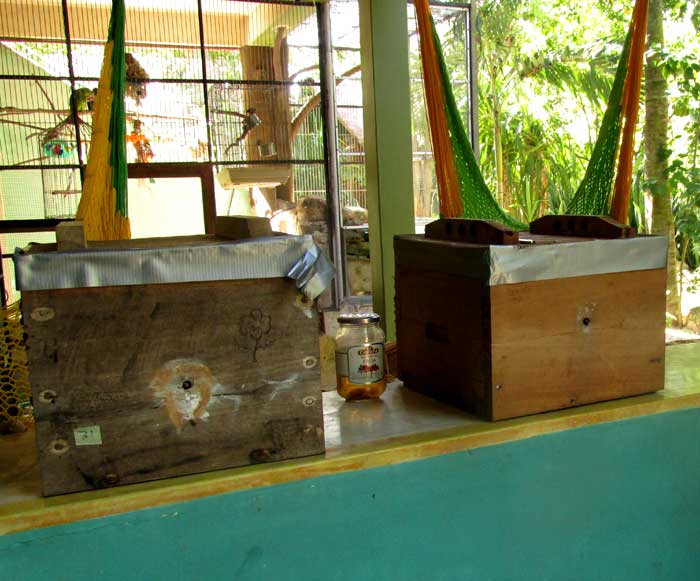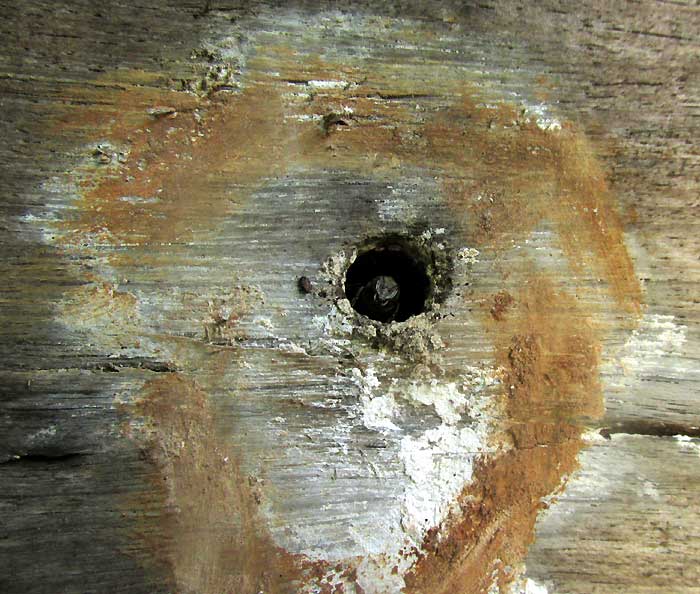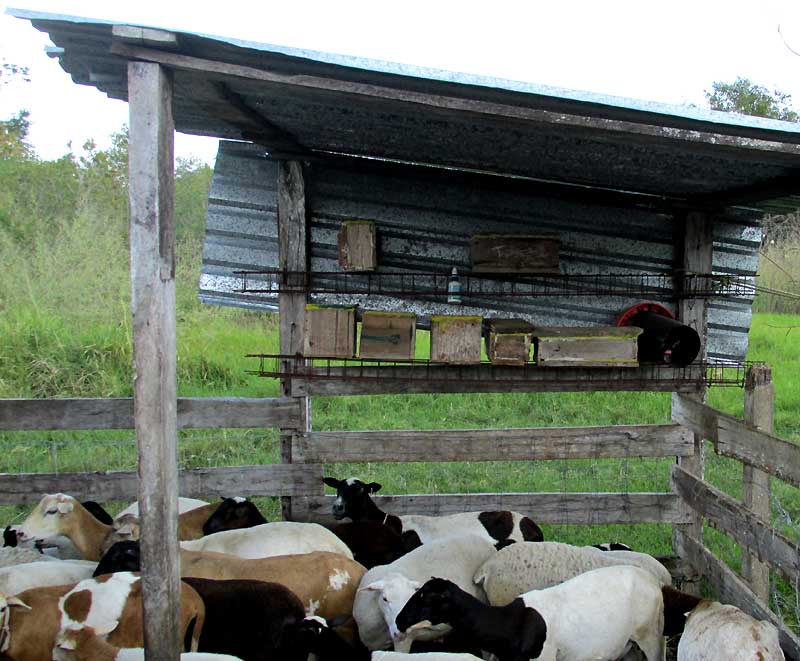Excerpts from Jim Conrad's
Naturalist Newsletter
from the January 11, 2019 Newsletter issued from Rancho Regensis north of Valladolid, Yucatán, MÉXICO;
elevation ~40m (~130 ft), N~20.876°, W~88.170°
XUNANCAB, THE FAMOUS MAYA STINGLESS BEE, OR MELIPONA
A few weeks ago a Canadian volunteer helper at Genesis, the eco-hotel whose owner also owns the rancho on which I am staying, set up the two little beehives at the semi-open edge of the hotel lobby, as shown

Much larger and differently constructed hives are commonly seen all over the Yucatan, because honey production is an important tradition with the Maya, and contributes significantly to the income of many Maya families. The hotel's two little hives also are different because the bees inside them are not the same species found in the commonly seen, larger hives. The larger hives are populated with the usual honeybee of European extraction, except that Yucatan's European bees now are "Africanized," carrying genes from those "killer bees" made famous by movies a few years ago.
The non-stinging bees in the hotel's little hives are MELIPONA BEECHEII, known to the Maya as Xunancab, and to English speakers either as Meliponas or Maya Stingless Bees, though below we'll see that these English names are pretty vague.
Inside one of the small boxes you can see fewer, smaller bees doing different jobs than normally seen in a hive of European bees, as shown below:

In that picture, the bees are busy working on two different structures. The large one with most bees on it, in the picture's center, is the part composed of cells in which eggs are laid, larvae fed, and from which new bees emerge. A close-up showing the bees at work atop this part, with the larval cells discernible as pale round spots in the image's top right corner, is seen below:

Charles Darwin paid close attention to the fact that the combs of Melipona beecheii are composed of round cells and not hexagonal ones, as with regular honeybees. He considered the round cells of Melipona beecheii as an intermediary evolutionary step up from the primitive bumblebees, who build globular structures and produce no honey, to honeybees with their hexagonal cells. Hexagonal cells enable less wax and labor to be invested in constructing more cells. To Darwin, these intermediary stages on the road to hexagonal cells indicated that something as complex as the honeybee's cell-making instinct could evolve from simpler nest-building instincts.
Attached to the hive's left side are several oval, closed structures, or "pots." These contain honey and/or pollen. We're not sure which are which because we haven't opened a pot to see what's inside. At this point we just want the bees to reproduce so that more hives can be created later by division of the colony. In fact, there's still a lot we don't know about this bee, and with luck I'll be reporting on our future discoveries.
In the above photo, to me it looks as if most bees carry gobs of honey, wax or resin atop their backs, or thoraxes, but I find no reference to such behavior in the literature. I do read that Melipona beecheii workers bear special wax-producing glands atop their abdomens, so maybe wax created there is shifted forward to the tops of their thoraxes and stored until enough accumulates to work with. That's just a wild guess.
A very interesting feature of their behavior is shown below:

Nearly always a bee guards the hives' single entry hole. When a worker arrives from the field carrying her load of pollen or nectar, the guard withdraws, and as soon as the worker is inside again, the guard resumes her station. Since these are stingless bees, the guard may be all bluff, and really she does seem a little menacing the way she faces us from the hole's center.
Now back to this bee's names. This is one of those rare occasions when the Maya name, Xunancab, may be more exact and useful than the name most English speakers may use, Maya Stingless Bee.
For, according to ITIS, the US government's Interagency Taxonomic Information System, as of early 2019, taxonomically, stingless honeybees are members of the Meliponini tribe of the family Apidae, which includes the vast majority of bees, from bumblebees to our stingless ones. However, the Meliponini tribe embraces 53 genera, and all the species in those 53 genera -- about 500 -- might rightly be called melipona bees. Or, at least meliponid bees.
One of those 53 genera is the genus Melipona itself. Even if you restrict the English name "melipona bee" to the genus Melipona, that genus itself includes about 63 species. A web page by SEGEY, the Dept. of Education for Yucatán state, says that in the Yucatan Peninsula 46 melipona species are to be found, though it's unclear whether they are referring to bees of the Meliponini tribe, or the genus Melipona.
For the most part, but not always, when the government and well informed people refer to the famous "Maya stingless bee, the Melipona," they are meaning the species Melipona beecheii, which occupies the small hives in the lobby at Genesis in Ek Balam.
Issued February 17, 2020 from the forest just west of Tepakán; elev. ~9m (~30 ft), N21.053°, W89.052°; north-central Yucatán state, MÉXICO
MY NEIGHBORS' BEES
As I was clearing along the rancho's boundary stone wall, my friendly neighbors Antonio and Jesús Cen came up from the other side and invited me to come see their sheep pen, one corner of which is shown below:

I was less interested in the sheep than the small wooden boxes on shelves in the background, for those are homemade hives for Melipona bees. Despite Melipona honey selling for a stiff price because of its medicinal value and appeal to tourists sensitive to the honey's cachet as a traditional Maya product, Antonio and Jesús don't sell their honey and aren't part of the government program encouraging the keeping of Melipona bees. They produce honey for their families because of its medicinal properties, and because it's what their ancestors did. Their bees were collected from the wild, just as in the old days. With our current hot, dry, windy days, the bees instead of producing honey are concentrating on making wax.